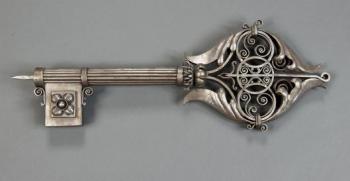Serendip is an independent site partnering with faculty at multiple colleges and universities around the world. Happy exploring!
Sign for a Locksmith

Sign for a Locksmith
To say I am not an artistic person is not completely accurate; I am not a two dimensionally artistic person. I can appreciate art and the talent that it takes to create beautiful paintings, but I rarely have intense emotional connections to images of things and people I do not know. Three-dimensional art, however, makes sense to me. It has a purpose, functional or not, and, having taken 3D art all four years of high school and worked with a variety of mediums, I can see how much work went into each individual element of an object. Because of this distinction I generally find art galleries and museums to be painful. I have to force myself to think about the paintings. I do not see a painting and just know this is the emotion I am meant to be feeling right now or the artist’s use of light is to symbolize the dreariness in the subject’s heart. But I can see a sculpture and know the artist must have spent ages getting those angles right or these elements were a bitch to assemble. This is what made the Barnes Foundation so refreshing: it was not a typical art museum. I could look at the Renoirs and Cézannes and then look up and see hinges and ladles and one giant key.

I don’t know why it was the giant key that struck me (metal was never my favorite medium-I preferred ceramics and stone) but I could not forget it once I passed it in Room 6. I never did this type of metal-work and I know I could never do something so beautifully intricate and distinct. My metal work was chunky and pointed and boring but this is elegant and round and perfect.
It was a sign for a locksmith in late 18th or early 19th century France (“Sign for a Locksmith”). It is made of iron. It is two feet long, eight and a half inches tall and two and half inches thick. But these are just physical characteristics that can be measured or determined. I was struck by the key’s size, but it was its appearance that stayed in my mind. The long, column-like body with a pointed end. The other end rounded and incorporated into the design of the handle. The symmetry of the swirls (or are they triskeles?). Every element of the sign was planned with care, each part connecting in some way to another.
Was this as highly regarded by people then as it is by me now?
Did people stop and admire at the artist’s craft? Did they notice the swirls behind the flourishes or the way the whole thing appears to be held together with simple bands? I marvel at the talent that it would take to make.
I want to touch the handle. To feel the curves of the swirls and points of the flourishes.
I imagine the coolness of the metal when my fingertips graze over the intricate spirals and circles and the dull pressure as I trace the end of the flourish. I feel the slight imperfections in the metal that appear after surviving more than two hundred years.
I close my eyes.
I see the street in France where this hung. High above the street over the door to the locksmith’s shop, alerting people to its presence. It goes unnoticed; it is normal for back then; we have lost this simplicity.
Why do I only have these feelings with artifacts?
I connect with the sign for a locksmith because I can relate to its creation. Making things as beautiful as you can only to have them passed by and ignored is heartbreaking.
Works Cited
"Sign for a Locksmith." The Barnes Foundation. Barnes Foundation, n.d. Web. 24 Nov. 2013.


